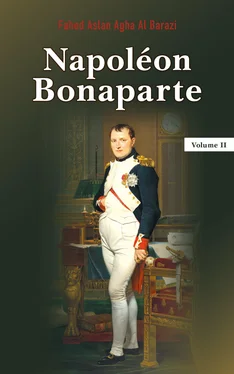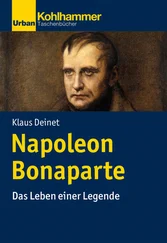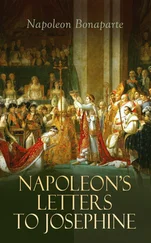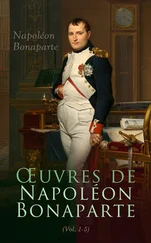Fahed Aslan Agha Al Barazi - Napoléon Bonaparte
Здесь есть возможность читать онлайн «Fahed Aslan Agha Al Barazi - Napoléon Bonaparte» — ознакомительный отрывок электронной книги совершенно бесплатно, а после прочтения отрывка купить полную версию. В некоторых случаях можно слушать аудио, скачать через торрент в формате fb2 и присутствует краткое содержание. Жанр: unrecognised, на английском языке. Описание произведения, (предисловие) а так же отзывы посетителей доступны на портале библиотеки ЛибКат.
- Название:Napoléon Bonaparte
- Автор:
- Жанр:
- Год:неизвестен
- ISBN:нет данных
- Рейтинг книги:4 / 5. Голосов: 1
-
Избранное:Добавить в избранное
- Отзывы:
-
Ваша оценка:
- 80
- 1
- 2
- 3
- 4
- 5
Napoléon Bonaparte: краткое содержание, описание и аннотация
Предлагаем к чтению аннотацию, описание, краткое содержание или предисловие (зависит от того, что написал сам автор книги «Napoléon Bonaparte»). Если вы не нашли необходимую информацию о книге — напишите в комментариях, мы постараемся отыскать её.
Napoléon Bonaparte — читать онлайн ознакомительный отрывок
Ниже представлен текст книги, разбитый по страницам. Система сохранения места последней прочитанной страницы, позволяет с удобством читать онлайн бесплатно книгу «Napoléon Bonaparte», без необходимости каждый раз заново искать на чём Вы остановились. Поставьте закладку, и сможете в любой момент перейти на страницу, на которой закончили чтение.
Интервал:
Закладка:
From the Federation of the Rhine and the valley of the Main, thousands of Germans had rallied to Napoléon’s colors in Spain. Now, the Emperor’s brother, young Jérôme, king of Westphalia, headed a thirty thousand man army of Westphalians to the Oder. Saxons marched to the Vistula; Bavarious and Wurttembergers moved east to join the Emperor; Poles commanded by Prince Poniatowski: sixty thousand men joined the Emperor’s Grande Armée. At the outset of 1812, it seemed that all Europe, from Rome to Warsaw to Tilsit, had rallied to Napoléon’s standard. Yet the Emperor was beset with doubts, for he knew only too well from earlier campaigns the difficulties resulting from logistics and supply lines extending over hundreds of miles. Now his troops, cavalry, artillery train, and medical corps would have to march much further and longer; from Paris to Warsaw about fifteen hundred miles, Warsaw to Moscow around twelve hundred miles. In Italy and Germany, his army lived off the conquered land. His movements in these countries were facilitated by well-constructed roads; in Russia, the roads either did not exist, or, if they did, they could hardly be adequate for the advance of 600 thousand men, the largest army Europe had ever seentill then.
More disquieting news was to await him; to his chagrin, in Gumbinnen he found out that very few mills were available for the huge amounts of grain he had collected in Germany. Throughout 1811 and part of 1812, he had been preparing for his great campaign; arsenals of weapons and ammunition, silos in the Baltic storing the amassed wheat and rice, countless ammunition, Silos in the Baltic storing the amassed wheat and rice, countless pieces of ordnance, pontoon bridges, building material, oxen drawn wagons and others carrying the medical corps. With this colossal army, the Emperor prepared to enter Russian territory. He delays his attack until June 1812, hoping that by then the grass would be green, and enough fodder would be available for the horses and beasts of burden.
“A Russian campaign is quite unlike the Austrian campaign; without supply and siege-trains, the enterprise will be in vain,” he wrote Eugene in Dec. 1811.
Of the six hundred thousand men, including the allied and vassal states that were now massing in Poland, three hundred were French, including the fifty-thousand-strong Imperial Guard commanded by Marshal Bessiéres. Except for the Imperial Guard, many of the young inexperienced recruits were to suffer the hardships of the Russian terrain and the long marches of the seemingly endless Russian Steppe. This fact became more apparent to the Emperor when in Danzig he was dining with Murat, Bessiéres and Rapp.
“How far is it from Danzig to Cadiz?” he asks Rapp.
Boldly, Rapp answers, “Too far, sire!”
Napoléon rejoins: “Gentlemen, it is clear that you have no taste left for fighting. Murat who had asked earlier for furlough would rather be back in his pretty kingdom; Rapp would prefer enjoying the pleasure of Parisian life; Berthier would rather be with his mistress Madame Giuseppina Visconti.”
Napoléon’s words were not altogether untrue; years of war had dulled the spirit of these fighting men, and now they’d rather enjoy their recompense in a more gratifying and tranquil life.
In April 1812, Bernadotte had swung Sweden to the Russian sire; he never liked the Emperor when he was his master, resentful of Napoléon’s rebuff when informed that “the Emperor does not communicate with an heir” when Bernadotte was the heir to the Swedish throne, and when he was sent off the field in disgrace at Wagram. Furthermore, the Continental System had taken its toll on the Swedish people, and was further aggravated by the French occupation of Swedish Pomerania in January 1812. These were enough reasons for the vexed Bernadotte to bring Sweden over to the Russian side.
When informed of Bernadotte’s rancorous shift, Napoléon remarked to Berthier, “I should have had him shot! I never trusted this turncoat.” Certainly, Sweden could not put in the field more than forty thousand troops at best; militarily this left no detrimental impact on the military situation.
Of major importance to Napoléon was his elite force, the Imperial Guards. In the 1812 campaign, Marshal Bessiéres, whose Mortier was in command of the striking arm of the Imperial Guard, the cavalry, was given its command. In Spain Bessiéres distinguished himself by heading the cavalry at Somosierra and pursuing the retreating Sir John Moore toward La Coruña. At Aspern-Essling, during the 1809 campaign, he headed the reserve cavalry with special distinction; he continued his valorous command of the Guard at Wagram. And now in 1812, Napoléon re-asserted his command of the Imperial Guard’s cavalry. In August 1810, Napoléon gave Bessiéres detailed instructions to re-organise the Imperial Guard into a cohesive, self-sustaining force. A reserve force of a hundred battalions was to be added to the Guard, bringing its strength up to ninety thousand men, equipped with an ordnance corps utilising the full range of artillery. The presence of the Imperial Guards on the battlefield was of such importance that it invariably either delivered the final crushing blow to the enemy, or at least restored the stability and confidence of the other branches of the army in a precarious situation.
On June 6, 1812, the Emperor ordered his Ambassador in St. Petersburg to collect his passport and return to Paris, and for the Russian Ambassador to leave France. Then, on June 22, he issued the following proclamation to the Grande Armée:
“This will be a glorious campaign for the French armies against Russia. We shall terminate the fifty-year Russian hegemony over Eastern Europe; and then conclude a peace treaty that will guarantee these terms.”
On June 24, 1812, from Kovno, the Emperor watched the leading regiments of the Grande Armée Cross the River Niemen. This colossal army of six hundred thousand men was marching across three pontoon bridges over the river. Not since the days of antiquity, when Darius the Great led an army of three hundred thousand men against Alexander the Great at Gogemala (now Iraq), had the world witnessed such a colossal army. For eight days they marched on across the pontoon bridges. For once, the disparity in numbers with the Russians was against the French. 150,000 horses for cavalry and other duties; where could they find enough fodder? Many would die from eating the thatched roofs of the hamlets they passed. The heterogeneous army was not a cohesive force as in earlier campaigns; it comprised of motley units of Poles (60,000 men) with their cavalry, Bavarians, Saxons, Dutch, Italians, Danes, and North Germans, with the French making up one third of the total force.
The Imperial Guard was the Elite striking force of the army. They were bedecked with elaborate uniforms, white breaches and bearskins, making the 160 cm tall Grenadier look taller and more intimidating (160cm was the minimum height). The Imperial Guard Cavalry, commanded by Marshal Bessiéres, formed the Ariete of the spearhead of the army when called upon to save a precarious situation; otherwise it was kept in reserve to deal with critical moments in the ensuing battle.
The Russian campaign, or the ‘Second Polish War’, as Napoléon called it, was intended to bring Russia to her knees, and most, including Napoléon, believed this enterprise would succeed. Unfolding events would prove otherwise.
On his campaigns, Napoléon travelled in his specially prepared coach. For the Russian campaign, he rode in a carriage drawn by six horses accompanied by his Chief of Staff Marshal Berthier. Every day he would review dispatches received from his Minister of Post in Paris. Maps and books for reading material were stacked inside the carriage and when books were read, they would be thrown out, strewn on the road behind.
Читать дальшеИнтервал:
Закладка:
Похожие книги на «Napoléon Bonaparte»
Представляем Вашему вниманию похожие книги на «Napoléon Bonaparte» списком для выбора. Мы отобрали схожую по названию и смыслу литературу в надежде предоставить читателям больше вариантов отыскать новые, интересные, ещё непрочитанные произведения.
Обсуждение, отзывы о книге «Napoléon Bonaparte» и просто собственные мнения читателей. Оставьте ваши комментарии, напишите, что Вы думаете о произведении, его смысле или главных героях. Укажите что конкретно понравилось, а что нет, и почему Вы так считаете.












